 Leading Blog | Posts by Category |
 Leading Blog | Posts by Category |
11.18.24

The Upside of Disruption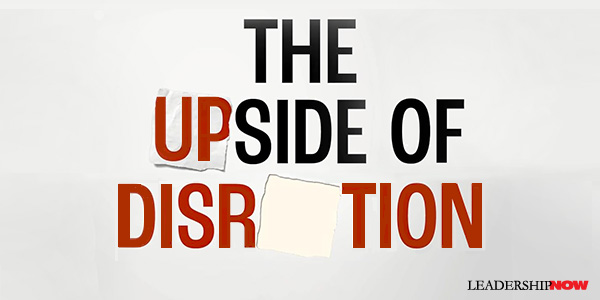
AS our recent history has shown us, disruption does not happen linearly. We can’t expect change to be an extension or an improvement on what we already know. As Terence Mauri puts it in The Upside of Disruption, we must rethink everything. “We can’t have resilient leadership without deliberate and sustained rethinking.” We become irrelevant, trapped in our past successes. Better questions are the answer to the now we find ourselves in. When operating at the edge of a new world, we must rethink old certainties, search for the upside, and ask what will evolve and what will not change because the untapped value lies there, too. The question leaders must now ask is, “Does our leadership deliver nutritional value through how we honor the past, define the present, and champion the future?” We can’t continue to lead with an Industrial Age mindset; rather, we need to adapt to an Intelligence Age mindset. The future is about a shift in mindset and related behaviors. To move our thinking out of the status quo and to find the upside of disruption, Mauri covers four critical areas leaders must address in themselves and their organizations. He refers to it as D.A.R.E. or Data, Agility, Risk, and Evolution. DATA – Lead with AI Data refers to AI-driven disruption. Embracing AI is a leadership priority but with a human-centric approach. “The more digital we become, the more human we need to be. The reimagination of mindsets, culture, and capabilities in sync with the rise of Al may be the leadership imperative of the twenty-first century.” Embracing AI requires a culture change. Employees should “feel energized and enabled to use AI as a co-pilot to do value-creating work and waste less time on bureaucratic misery work.” AGILITY – Great Leaders Unlearn Mauri defines unlearning as the capacity to reflect (humility), rethink (agility), and then renew (growth). It’s proactive, not reactive. “Half of wisdom is learning what to unlearn,” said science fiction writer Larry Niven. Unlearning could be the highest form of learning in a post-AI world. It’s the ultimate insurance policy against zombie leadership (dead leadership that fails to adapt to changing circumstances) and “enshittification” – a term coined by academic Cary Doctorow to describe the slow decay in everything we do. It is at the heart of every future-focused organization, allowing leaders to focus on accelerated growth and rethink outdated mindsets. RISK – The Courage Advantage The risk is in not having the courage to evolve. Adopt a contrarian mindset. “Willful contrarianism explicitly takes a point of view about the future that runs counter to conventional business wisdom and is a powerful antidote to the curse of sameness. Leaders courageous enough to adopt willful contrarianism are likelier to see the future first and hone a courage edge that helps them take advantage of disruption and seize new growth opportunities.” Our current mindset affects our ability to see the future. Mauri says courage and humility are inseparable because there is no courage without vulnerability. Overthinking leads to risk aversion. EVOLUTION – In Trust, We Grow For some time, trust has been on the decline. Mauri encourages us to adapt the Trust Mindset and utilize its three dimensions: Who We Are (Identity), How We Work (Agility), and How We Grow (Scalability). The Who We Are question provides clarity. It is about values. But keep it simple. “Too many can be counterproductive. Values should be clear and meaningful and guide mindsets, behaviors, and decision-making about what you are and are not.” How We Work answers the question, “Are we empowered to work as adults, or is ‘fake empowerment’ the default? Empowerment means control over context and power over trust. It demands deference and erodes initiative.” Move from micro-management to continuous coaching. Be a leader of learning, not tasks. How We Grow provides a growth story that people can relate to and get behind. “When leaders honor past achievements, define the present challenges, and inclusively shape the future growth story, people don’t just feel included in the journey; they own their part of the future in a crystal clear and irresistible way.” We won’t succeed in the Intelligence Age if we are stuck in the status quo. We need a beginner’s mindset and the courage to make bold moves. Whatever the future holds, people will still want to thrive in human-led, trust-based cultures that combine meaning, choice, and opportunity over a lifetime. 
Posted by Michael McKinney at 03:14 PM
10.18.24

Signs Your Organization’s Culture Needs to Change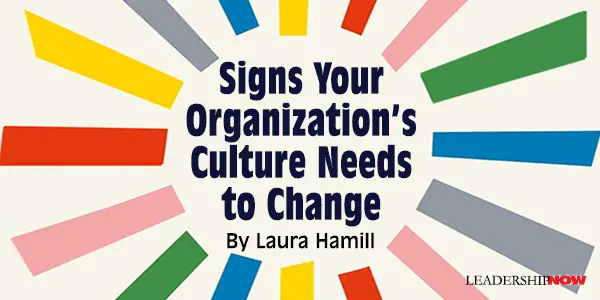
CULTURE has the power to inspire and unite an entire workforce in the service of common goals. It can create meaning and purpose and a positive day-to-day experience while ensuring that the company is well positioned to meet its business objectives. But when an organization’s culture is negative and dysfunctional, it has the opposite effect. A study from MIT/Sloan found that a toxic culture is by far the strongest predictor of employee attrition. Signs that an organization needs to evolve its culture can be obvious — business results are suffering, employees are leaving, or recruitment has become difficult. Let’s say your employee survey results across multiple teams tell you that cross-group collaboration is low despite efforts to encourage employees to collaborate. It would be important to dig into what’s fundamentally valued in the culture that might be reinforcing individual performance (or even reinforcing competitiveness) between employees. When investigating signs that the organization’s culture may be getting in the way of meeting the goals of the business, you need want to: Examine what the data say. Look out for trends and patterns in any data that you have, for example, employee surveys, exit interviews, customer complaints, and online reviews. If the same things come up time and again, dig deeper to look at them from a cultural perspective. Explore recruitment and retention difficulties. Your culture might need more attention if people are leaving in higher numbers than in the past, or if you’re having difficulty attracting new candidates to your organization. Even if the culture isn’t actually hostile or toxic, it can still be one that isn’t thriving — and employees and candidates will vote with their feet. Investigate a lack of employee participation and engagement. If people are showing signs of disengagement — for example, no longer attending company meetings or no longer asking questions — this may be an indication of withdrawal from the culture and a precursor to people leaving. It’s another early sign that you may need to work on your culture. Consider disconnects between leaders and employees. Another big tell is a lack of connection and alignment between leaders and employees, even though there’s been lots of communication. For example, employees might refer to the company and company leadership as “they” rather than saying “we” or “us.” Or leaders have an us versus them mentality when referring to people in the organization, consistently blaming the workforce or a lack of talent for not achieving business results. Another indicator is when leaders don’t engage with or listen to employees. If leaders aren’t role models for the culture, if they blame others rather than taking ownership themselves, it’s a sign that the culture (and the leaders) need to evolve. Are you ready to change? It’s one thing to know that you have a culture problem. It’s a completely different thing to know if the organization is ready to change. Make sure these tactics are in place as you begin to embark on a cultural evolution for your organization: 1. Ensure leaders are the primary voices. The CEO and leadership team must see culture work as critical to the success of the company and be ready to do the work and be the voice of the evolution. Furthermore, they can’t just be talking heads or going through the motions — there must be an authentic commitment from these leaders to do the work. This doesn’t mean that others in the organization can’t also be culture change drivers, but without the CEO and other leaders being involved it will be difficult for the change to be implemented and almost impossible for the change to stick. 2. Have a clear “why.” Because culture feels both personal and deeply rooted, it’s important to have a clear “why” for the culture work. There needs to be a sense of urgency and a clear, meaningful reason for things to change. It’s important to draw explicit connections with the organization’s strategy and purpose. Culture work should always be focused on solving business problems. Be clear about what problems you’re trying to solve through the culture change. 3. Know where you’re starting from. Given that your organization is unique and will start on culture work from your specific place, there are different types of culture work your organization might pursue. You may be trying to understand the current culture. You may be trying to create or form your aspirational culture. You may want to work out how to compare the current culture with the aspirational culture and close the gaps between the two. Or, your culture work may involve making the culture come to life throughout the organization to ensure that the experience of culture is woven throughout the organization. No matter the type of culture work you’re doing, you must be intentional about it. Change is a process that requires intention and time. Culture is complex, elusive, and multifaceted — just like the humans who create it. And just like the humans who create culture, there’s unlimited potential to evolve your understanding of culture and make work better. If the signs are saying your culture needs to change, for your people’s and your company’s sake, don’t ignore them.  
Posted by Michael McKinney at 07:11 AM

Signs Your Organization’s Culture Needs to Change
CULTURE has the power to inspire and unite an entire workforce in the service of common goals. It can create meaning and purpose and a positive day-to-day experience while ensuring that the company is well positioned to meet its business objectives. But when an organization’s culture is negative and dysfunctional, it has the opposite effect. A study from MIT/Sloan found that a toxic culture is by far the strongest predictor of employee attrition. Signs that an organization needs to evolve its culture can be obvious — business results are suffering, employees are leaving, or recruitment has become difficult. Let’s say your employee survey results across multiple teams tell you that cross-group collaboration is low despite efforts to encourage employees to collaborate. It would be important to dig into what’s fundamentally valued in the culture that might be reinforcing individual performance (or even reinforcing competitiveness) between employees. When investigating signs that the organization’s culture may be getting in the way of meeting the goals of the business, you need want to: Examine what the data say. Look out for trends and patterns in any data that you have, for example, employee surveys, exit interviews, customer complaints, and online reviews. If the same things come up time and again, dig deeper to look at them from a cultural perspective. Explore recruitment and retention difficulties. Your culture might need more attention if people are leaving in higher numbers than in the past, or if you’re having difficulty attracting new candidates to your organization. Even if the culture isn’t actually hostile or toxic, it can still be one that isn’t thriving — and employees and candidates will vote with their feet. Investigate a lack of employee participation and engagement. If people are showing signs of disengagement — for example, no longer attending company meetings or no longer asking questions — this may be an indication of withdrawal from the culture and a precursor to people leaving. It’s another early sign that you may need to work on your culture. Consider disconnects between leaders and employees. Another big tell is a lack of connection and alignment between leaders and employees, even though there’s been lots of communication. For example, employees might refer to the company and company leadership as “they” rather than saying “we” or “us.” Or leaders have an us versus them mentality when referring to people in the organization, consistently blaming the workforce or a lack of talent for not achieving business results. Another indicator is when leaders don’t engage with or listen to employees. If leaders aren’t role models for the culture, if they blame others rather than taking ownership themselves, it’s a sign that the culture (and the leaders) need to evolve. Are you ready to change? It’s one thing to know that you have a culture problem. It’s a completely different thing to know if the organization is ready to change. Make sure these tactics are in place as you begin to embark on a cultural evolution for your organization: 1. Ensure leaders are the primary voices. The CEO and leadership team must see culture work as critical to the success of the company and be ready to do the work and be the voice of the evolution. Furthermore, they can’t just be talking heads or going through the motions — there must be an authentic commitment from these leaders to do the work. This doesn’t mean that others in the organization can’t also be culture change drivers, but without the CEO and other leaders being involved it will be difficult for the change to be implemented and almost impossible for the change to stick. 2. Have a clear “why.” Because culture feels both personal and deeply rooted, it’s important to have a clear “why” for the culture work. There needs to be a sense of urgency and a clear, meaningful reason for things to change. It’s important to draw explicit connections with the organization’s strategy and purpose. Culture work should always be focused on solving business problems. Be clear about what problems you’re trying to solve through the culture change. 3. Know where you’re starting from. Given that your organization is unique and will start on culture work from your specific place, there are different types of culture work your organization might pursue. You may be trying to understand the current culture. You may be trying to create or form your aspirational culture. You may want to work out how to compare the current culture with the aspirational culture and close the gaps between the two. Or, your culture work may involve making the culture come to life throughout the organization to ensure that the experience of culture is woven throughout the organization. No matter the type of culture work you’re doing, you must be intentional about it. Change is a process that requires intention and time. Culture is complex, elusive, and multifaceted — just like the humans who create it. And just like the humans who create culture, there’s unlimited potential to evolve your understanding of culture and make work better. If the signs are saying your culture needs to change, for your people’s and your company’s sake, don’t ignore them.  
Posted by Michael McKinney at 07:11 AM
08.05.24

What Leadership Needs to Know about Changing Organizational Culture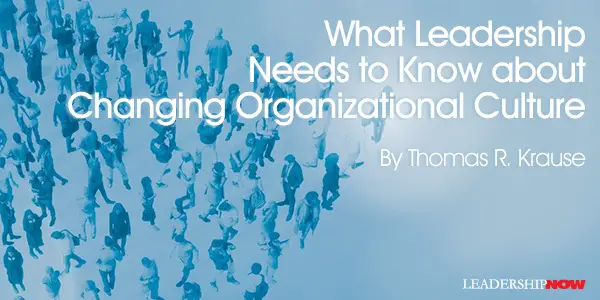
SAY you have a manufacturing location with problems — three plant managers in two years, unusual variation in quality and/or safety, seemingly unpredictable swings in productivity. The options senior leadership considers may be to sell it, give it a defined period to show or go, or take on the task of rehabilitation. Leadership may wonder whether this is essentially a culture problem or whether poor performance itself creates what looks like one. And, if it is the culture that needs to change, what does that really mean? What murky business may be happening underneath that gets recognized as a “culture problem?” And, if the main issue is the culture, what’s the right strategy to change it? Will it take five years? Who has five years? To sort this out, here are important aspects of culture to know: 1. Changing the climate changes the culture. It might take five years to “change the culture,” but that’s irrelevant. Your leaders can change the climate almost immediately. Climate is what leaders are paying attention to and pushing right now. Hold the climate steady for six months, and the culture will start to change. 2. Frequent climate changes negatively affect culture. The problem is that, given leadership turnover, shifting markets and demands, and unexpected changes, the likely pattern is that the climate change will run its course in less than a year and then fade. This isn’t long enough to cause a lasting change in the culture. Then, after this happens a few times, you’ll have influenced the culture, but for the worse, not the better. You’ll have established the expectation that whatever leadership is pushing right now will change fairly quickly, so it doesn’t need to be taken seriously. This is a change in culture, but the opposite of what was needed and intended. 3. Clarify that “organizational culture” isn’t an academic question. Instead, it’s a practical one. The phrase has been kicked around for many years and has taken on different meanings. Some are more useful than others. A common meaning is “how we do things around here.” Another is “what we value.” When you visit a manufacturing location, you start learning about its culture almost immediately — the way you’re treated at the gate, the video you’re told to watch, the looks on the faces of the people you meet, how the first meeting is started, how people conduct and respond in the meeting, how people answer your questions as you tour the facility, what questions they ask you. Within a few hours, you start to have a feel for the place. Would you want your son or daughter to work there? 4. Examine culture via organizational functioning. The most useful way of understanding culture is “how things get done.” Operationally, this means things like communication (especially upward), level of support, trust in leadership, level of teamwork, and perception of justice. 5. Steer away from emphasizing how “leadership creates the culture.” This isn’t because the notion is false but because your leaders don’t understand it. It feels to them like blame, and maybe it is. It sounds like you think leaders are intentionally creating a poor culture, which must be false. A more accurate and useful way of putting it is that leadership decision-making has unintended consequences that show up as cultural issues. 6. Realize the unintended consequences of leadership decision-making. A good way to do this is to analyze decisions related to some seriously negative outcomes. Identify three examples of failed outcomes (related to quality, safety, personnel change, supply chain problem, etc.). Then, trace back and identify the decisions leaders made that led to the failing. Take, for example, a recycling plant catastrophe in which three workers are killed following two explosions. The investigation shows that a used blade scraped the side of the vessel, causing a spark that caused the first explosion, which ignited combustible dust stored nearby and caused the second explosion. Ordered by time, the relevant failed decisions were: 1) A worker replaced a blade in the vessel with a used blade. For many organizations, the “cause” would be identified here, and the investigation would stop. The fix would focus on the employee whose behavior was the issue. Looking further would show that: 2) A decision made by supervision to replace worn blades with used blades was common, happened frequently, and didn’t usually cause problems. Supervision knew this was a common practice. Also, 3) Decisions by management to accept storage of combustible material in proximity of the mixing vessel contributed to the accident. 7. Explore whether analysis suggests a culture issue. Determine whether behavior that leads to sub-optimal operation has become part of the culture. The technical term for this is “normalization of deviance.” If poor upward communication and low support are culprits, both are measurable cultural factors. This pattern was found at NASA after the Columbia Space Shuttle tragedy and is often found in relation to negative outcomes. The central point here is that leadership tended to blame the employee when, in actuality, it was leadership decision-making that created the culture factors that caused the event. Whatever else is going on at a location, knowing how these critical aspects of culture are seen and operationalized will tell you the majority of what you need to know about the culture of the organization. 
Posted by Michael McKinney at 06:29 AM
07.08.24

Why You Need a Culture of Growth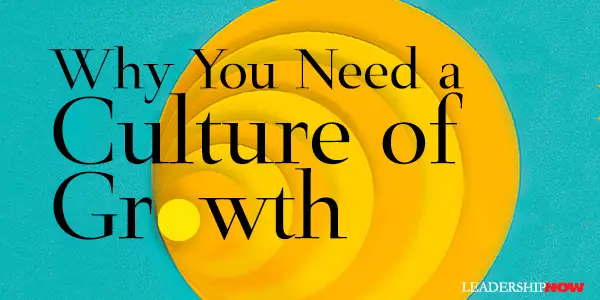
A SECRET to lifelong success is to always be in learning mode, personally and organizationally. In Cultures of Growth, Mary Murphy contrasts a Culture of Growth with its growth mindset and the fixed mindset of a Culture of Genius. These mindsets exist on a continuum. We don’t just have one or the other. We are not static. We frequently shift from one to the other depending on what we are experiencing. Instead of questioning if a person has a fixed or a growth mindset, the question we should ask is: “When are you in a fixed mindset, and when are you in a growth mindset?” In aiming to evaluate individuals’ mindset set points, organizations often end up putting an inordinate amount of focus on what employees bring to the table and not enough on how that table is constructed. Too often, we label people as one or the other without considering the context and the culture that creates and maintains a particular mindset. “The culture surrounding us is one of the biggest influences on our beliefs, motivations, and behavior. This mindset culture exists at the group and organizational level.” Critical to our job as leaders is the understanding that “Mindset culture is so powerful that it can actually block an individual’s growth mindset.” A Culture of Growth encourages confidence and intrinsic motivation, process orientation, a tolerance for risk, and resilience. A Culture of Genius is characterized by know-it-alls, status, talent, competition, task orientation, limited potential and opportunities, and a lack of trust.
Cultures of Growth are what we think of when we talk about learning organizations; every day is a treasure hunt, with employees searching for novel ideas to improve products and processes. Cultures of Genius are primarily leaning organizations, which lean on the status quo or how things were done in the past to direct their current efforts. A fixed mindset is not all bad. A fixed mindset can be useful in some situations, but it should be tempered with the humility to see other perspectives. A chronically fixed mindset will restrict our ability to see the possibilities in ourselves and others. Events can trigger fixed mindsets. The job of leaders is to minimize that and teach people to reframe events to encourage a growth mindset. It’s not important to have all of the answers but to encourage others to find the answers. Murphy suggests that the situation and the culture we are in often plays a “stronger role in shaping our behavior than our character does.” Sadly, this is true. But it does reflect a lack of character. Character compels us to do what we know is right in spite of our situation and what those around us may allow. That said, we should ensure that the culture we are responsible for does not place people in a situation that encourages them to compromise. Poorly thought-out performance goals and incentives can do just that. Murphy identifies four areas that are prone to placing us into a fixed mindset that we should be aware of: evaluative situations, high-effort situations, critical feedback, and seeing the success of others. When we anticipate a situation where we are being evaluated by others, we naturally tend to go on the defensive. We become hyper-focused on defending our performance rather than improving our thinking and behavior. Think contribution and not competition. High-effort situations require that we apply more effort, time, and attention than we have in the past. In a fixed mindset, we negatively correlate our abilities with the effort required to succeed. “If I have to work this hard, then I must not have what it takes to see it through.” A growth mindset reframes the situation with the belief that this is a challenge that can push us to learn and discover the path to reach our goals. Murphy cautions, “A growth mindset isn’t just about putting in sheer effort; it’s far more discerning than that, and it’s also far more expansive. When we’re in our growth mindset, we find ways to invite challenge in and to play with the struggle it brings. We focus on possibilities, try new strategies, and experiment. And we do it in a conscious, thoughtful way.” Like evaluative situations, when it comes to critical feedback, most of us initially react with a fixed mindset. We tend to take it personally, especially if it is vague and delivered in a judgmental manner. That’s when we need to ask ourselves, “Do I want to be better, or feel better?” When we’re in our growth mindset, our learning and development are priorities, so we are constantly attending to where we are recalibrating our perceptions and expectations, fine-tuning our self-awareness in these areas. We’re able to engage in a more subtle discernment process when faced with critical feedback than when we’re in our fixed mindset. When we do receive feedback that doesn’t comport with where we believe we are, we are better equipped to evaluate its usefulness. When people are coming from their own fixed mindset, their feedback is not about growth, but is more designed to make themselves feel better about their own issues. Even then, you can find hidden gems to help you better understand the situation you find yourself in. Jealousy will put us in a fixed mindset. Feeling threatened, we begin to internalize reasons why we can’t do what they did or assume that they are just better than we are. Success, we think, is outside of our control. In this state, we fail to see what we need to do to achieve the success we seek. A Culture of Growth may not change us overnight, but it will provide a perspective that allows us to see better the possibilities for other ways of being and functioning. An environment where growth is prioritized shapes how we make sense of the world around us and how we can reach our potential within it. 
Posted by Michael McKinney at 01:41 PM
07.05.24

What is the Gouge?
NAVY SEALs talk about the Gouge. But what is it? It’s not a thing but mental readiness—a preparedness that is based on some foundational beliefs. It is a place you bring yourself and others to mentally. It is defined by Admiral and former Navy SEAL Bob Harward in The Gouge!, as “the contract we all have with humanity, sharing the best of everyone for the collective well-being of all. It was always intended to be information you could believe in, people you could trust, organizations you could rely on because it came from people who wanted the best for you, and therefore good for all.” What caught my attention was the subtitle of the book: How to Be Smarter Than the Situation You Are In. The Gouge is more than just good advice shared with others. It is a perspective that brings out the best in others. It is a decision-making tool that presents obstacles as choices. Harward explains: Each choice is filtered through the collective experience and wisdom of those participating and reinforced accountability to each other and to yourself, faith in one another, and inherent trust, which facilitates deliberate action. Once the choice is made, you’re committed and focused on making the right choice. To have Gouge, you must be a tuned-in person with the following fundamental beliefs: Mission First. People Always. We can make others better every day. As a leader, “you are a participant in human development. If we can take care of people and each other, the rest of it will come.” Looking out for others builds trust and confidence. The mission succeeds when people succeed. Purpose Defines You. Embrace It. It all comes down to purpose. Leaders reinforce and leverage purpose. “If Gouge is about the information that links -all of us together, our purpose is the bedrock on which Gouge is built. It determines who you are, reinforces your belief, and ultimately determines your success.” We Are All Accountable for Ourselves and Others Looking out for each other requires accountability at all levels. It must come from above and below. “Lack of accountability is a slippery slope that is hard to stop once it festers itself in any organization or team. Accountability and confrontation are aligned. If you’re going to avoid confrontation, you’ll never hold anyone accountable.” Constructive, forward-looking confrontation is a part of accountability. Anonymity kills accountability. You don’t have to own what you say. While social media can be used for good, it has created cultural accountability problems. “Tweeting. Posting on Facebook. All of those sites put a barrier between human connection, allowing people to refuse accountability for what they’re saying or doing.” The best leaders know how to effectively implement it to get the best results for their team so they can fulfill their purpose. During any confrontation, remember we are one community with a purpose. Faith In People Is My Religion Faith in each other builds community. “It is essential because if you don’t have faith in one another, there is no trust, no passing of information or guidance, and the whole system breaks down.” This faith is placed in the bond between two people, casting your dot with your fellow man in hopes of achieving a common goal. Never Quit, but Saying No Is Always an Option For Navy SEALS, quitting is a mortal sin. No matter the demands, never quit. But there are times when the best Gouge is to quit. Sometimes, saying no is “just an opportunity to say yes to something else.” Sometimes, saying no forces you to live up to your maximum potential. Great Leaders Share Gouge Empower and support others through Gouge. Show them through your actions. “By showing your people that you see them not as a way to accomplish a mission but as teammates working with you to accomplish a mission. Make sure everyone is armed with the best information so they can not only do the job but so they can sync it with their purpose.” What About Bad Gouge? When people are working at cross purposes, there is bad Gouge. When you find yourself in a new situation, you need to recalibrate. “You have to think to yourself: Is someone trying to sell me something? Does it benefit this person/company in any way if they influence my thinking one way or another? Does this person have credibility?” Many times, bad Gouge is simply being surrounded by the wrong people. Good Gouge only comes from relationships where everyone is on the same page and working toward the same goal. Identify Your Own Gouge To identify your Gouge, “think about the essential personal and professional information you want your employees, team, and children to know. Focus on empowering those around you instead of yourself, and watch how successful you become. Always look to better yourself and better those around you, and always be courageous enough to communicate it. The Gouge is very simple. It is information used to create a better outcome for all.” 
Posted by Michael McKinney at 06:07 PM
02.09.24

Evolve or Dissolve: Shaping Your Corporate Culture for a Remote Reality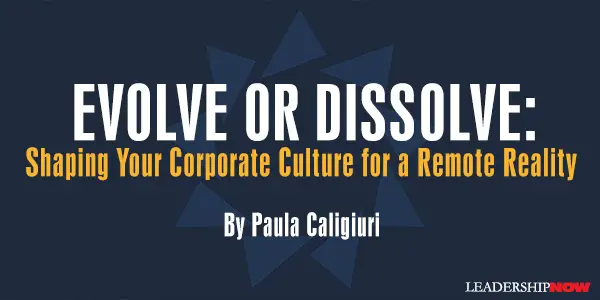
IN THE PAST DECADE, the corporate world has seen a seismic shift in how it operates. The advent of technology that enables remote work combined with the ever-increasing rate of employee turnover in many industries has led to a transformation in the very fabric of organizational culture. Businesses striving to adapt and thrive amidst these changes must find innovative solutions to the matter of maintaining a robust corporate culture. The Erosion of Traditional Corporate Culture A strong corporate culture will influence how team members interact and conduct business. Teams operating within a strong culture share a set of values, beliefs, and behaviors. These are learned over time and socialized when newcomers “learn the ropes” from interactions with and observation of colleagues and leaders. But today’s decentralized office environment makes it harder to socialize culture, foster a sense of unity, and reinforce shared values. Additionally, greater turnover rates disrupt continuity and the transmission of cultural values, leading to a disjointed and often weakened corporate identity. Importantly, if corporate culture is left unattended, over time it will weaken and dissolve. Remote Work: A Double-Edged Sword While remote work offers flexibility and can increase productivity, it limits opportunities for spontaneous collaboration and social interaction — both crucial for building a cohesive culture. Without the organic conversations that occur in physical office spaces, employees can feel isolated and new hires may struggle to assimilate into the company’s ethos.In attempting to bridge this gap, Google, for example, has invested in virtual reality technology to create more immersive and interactive remote meetings. Using a very different approach, companies like Yahoo and IBM, once pioneers in remote work, reconsidered their remote work policies and brought team members back into the office to preserve their corporate culture. The Impact of High Turnover Frequent employee turnover further complicates the picture. Each departure is a loss of cultural knowledge, and each new hire is a potential cultural reset. This constant flux can make it more challenging to maintain a stable and consistent corporate culture. If companies experience increases in short tenure among senior associates, they will have fewer leaders able to transmit the corporate culture. Some industries, such as professional services, hospitality, and retail, are experiencing higher turnover rates, impacting the maintenance of strong corporate cultures. 5 Strategies to Strengthen a Weakening Corporate Culture In response to these challenges, companies must be proactive in nurturing and evolving their corporate cultures. Here are five strategies to consider:
The evolving landscape of work presents unique challenges to maintaining a strong corporate culture. However, with thoughtful strategies and tools like myGiide, companies can adapt and even thrive in this new era. By focusing on communication, connection, adaptation, socialization, and recognition, organizations can forge a resilient and dynamic culture that withstands the tests of distance and turnover.  
Posted by Michael McKinney at 10:38 AM
12.22.23

Managing Company Culture Anthropologically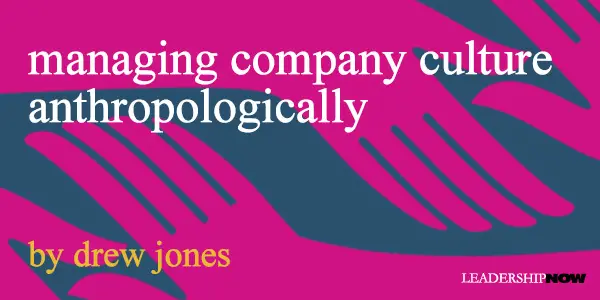
BUSINESSES are really bad at establishing an engaging culture. Despite its perceived importance, for the most part, companies have a miserable track record when it comes to managing their people. On the one hand, most CEOs agree with with the statement attributed to Peter Drucker: culture eats strategy for breakfast. Yet, on the other hand, the data shows that following through on this conviction can be elusive. The Culture Dilemma Employee engagement in American companies has hovered around 30 percent for 60 years. Seventy percent of corporate “change programs” fail to achieve their stated goals. Large firms spend around $2,200 per employee per year on culture, yet only 30 percent of those efforts have a positive ROI. Further, only 69 percent of employees believe in the cultural aspirations of their leaders, and a full 90 percent of employees don’t behave in ways that align with those aspirations. Companies consistently get culture wrong because they go about assessing it, and attempting to manage it from the top-down, not the bottom-up. But what does this mean? Typically, a large organization will administer a culture survey — a large inventory of questions that results in placing the “company culture” into one of several “culture types” or “culture orientations.” The survey reveals the culture that a company has now and gives it an idea of what “type” of culture it can have in the future. This approach plays right into the hands of eager consultants because getting from the current culture to the desired future culture becomes a gap-closing program. Consultants love a gap-closing program almost as much as they love a SWOT analysis. Ticking the boxes of a culture survey is satisfying for an HR manager because she collects “data at scale,” which is generally referenced in numbers, pie-charts, and graphs of various shapes. However, the gap-closing process falls apart quickly when the company compels employees to change their behavior in order for the company to arrive at its future desired culture. Data clearly indicates that this does not work. The Anthropological Alternative Anthropology as a discipline has been studying cultures around the world for more than 150 years. Anthropologists set out to understand culture through the qualitative research method of ethnography — the process of spending time with research subjects in the actual contexts where they live, work, shop, play, and celebrate. Ethnography is premised on empathy, and the goal is to understand a given culture from the “natives’” point of view — through their eyes, in their words. Ethnography allows a researcher to focus on the lived experiences of people and how those experiences reflect and shape culture in that environment. The Employee Experience (EX) Imperative No survey architect, as brilliant as they may be, can really know anything about the specific experiences of employees in a particular company. Their culture types are a mere shorthand in the quest for hard data. Companies that focus anthropologically on employee experiences can shape cultures in ways consistent with the aspirations and goals of their employees. Typically defined as the “values, beliefs, and behaviors” that people in organizations share, corporate culture too often remains an unattainable abstraction. A shift to the everyday experiences of employees shifts the focus of what culture is in an organization. An EX approach to culture focuses on the tangible, daily experiences of employees and what those mean to employees (again, in their words). Among others, five tangible aspects of work in particular, shape experience, and culture. 1. Why: Purpose and meaning - Humans are a storytelling species, and we value being a part of a meaningful story. Culture starts with a compelling story. Does the company story resonate? 2. What: Learning and growth - People are natural learners and experimenters. How much of their full cognitive and intellectual muscles are being used? 3. How: Autonomy and flexibility - Humans self-organize and accomplish things most effectively without too much management. How does the organization enable teamwork? 4. Who: Leadership trust - Does leadership trust its employees to take risks without fear of being punished? Do they allow people to be themselves at work? 5. Where: Community - Does the company campus, or digital infrastructure, successfully balance employees’ need for community and autonomy? An EX approach to understanding a company’s culture starts with questions like these, in which employees are encouraged to elaborate, in ethnographic interviews, on how they (and not a survey writer) feel about the questions. Work-Life Shift at Fujitsu Fujitsu, the Japanese digital transformation conglomerate, exemplifies the power of an EX approach to managing its people. In response to the Covid-19 pandemic, Fujitsu introduced a radically employee-centric new approach to managing its people. Focusing on people first, they introduced several changes from which any company can learn. • Digital-first: They shifted to a digital-first working model, allowing employees to work from home if they chose to. The goal was to help employees put their family needs first. • Coworking-like offices: They closed their large downtown offices in Tokyo and shifted to small, satellite coworking-like spaces in the suburbs so that employees who did want to work at an office didn’t have to commute very far. Also, start-up companies in the Fujitsu technology accelerator program work in the satellite locations as well, creating a company-startup mashup. • Autonomy: They are working to devolve critical decision-making to the individual and team level to cultivate an atmosphere of autonomy and self-directed work. • Passion projects: They now allow employees to take outside employment or to start their own businesses on top of their commitments to Fujitsu. This is a recognition that employees have passions they aren’t fulfilling at the company and that they value that for their employees. Every industry is different, and every company is unique, so there’s no one-size-fits-all solution for addressing the culture dilemma. However, starting with a thoughtful and empathetic consideration of employee experience and taking that seriously is a fruitful way to start. Fujitsu’s Work-Life Shift program clearly demonstrates that.  
Posted by Michael McKinney at 10:56 AM
03.20.23

Culture is the Way: 5 Steps to Building a World-Class Culture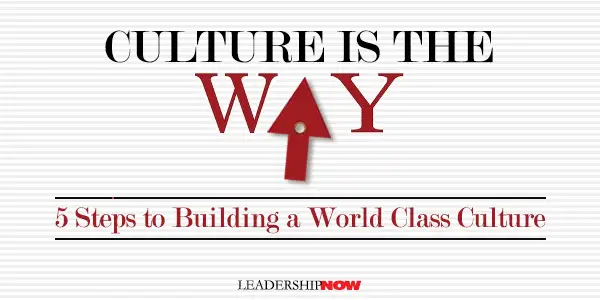
YOU CAN CHANGE the results your organization is getting by changing its culture. And every organization has a culture whether it is by design or by default. “Whether an organization has a world-class culture or a toxic one, its future depends on how much attention and focus it puts on growing its culture,” writes Matt Mayberry, the author of Culture is the Way: How Leaders at Every Level Build an Organization for Speed, Impact, and Excellence. Culture serves as the internal compass for an organization’s fundamental beliefs, how the organization behaves daily, and its level of market performance. To begin, let’s look at the five most common roadblocks that stop us in our pursuit of cultural excellence that Mayberry addresses: 1. Lukewarm leadership buy-in. “Most senior leadership teams consist of accomplished leaders with a wealth of experience, and the last thing the majority of them will want to do is shift their leadership style or change how they have done things for the past ten to twenty years.” 2. All slogans and no action. “Words don’t build culture or change culture by themselves. It takes action. Culture is not about turning values into behaviors. It’s about turning values into repeatable behaviors, into actions that become daily habits that are shared across the organization.” 3. Temptation of instant gratification. “When we have a strong desire for something, our patience is severely tested. Any goal worth achieving, whether it’s a personal goal, a professional aspiration, or building a great workplace culture, requires a delicate balance of tenacity and extraordinary patience.” 4. Distortion and distraction. Just throwing ideas around and seeing what sticks and what doesn’t isn’t going to get you any closer to a solution, and it could actually do more harm than good. You must use caution when rushing to adopt and implement an idea that you read about.” 5. Lack of cascading change. There is no end date. It is an ongoing commitment. “Being interested is not the same as action taken. Being interested in creating a great culture is exactly that. Interest. It will never progress unless consistent action is taken.”
Here is an overview of his five-step process: Step One: Define Your Culture You must be ruthlessly clear about who you are as an organization. The culture has to be clearly defined so that everyone knows what you mean when we say, “our culture is.” Everyone must see the culture in the same way. “Great cultures are defined cultures. This means that every leader, manager, and employee can describe the culture and what it stands for, and the descriptions will be very similar to a large extent.” Step Two: Discovery Through Collaboration and Inspiration “Changing culture begins with changing one person’s mindset and behavior at a time. And changing mindsets and behaviors, especially at scale, necessitates making people feel like they are a vital part of the process rather than relying on old engagement methods.” Take a bottom-up approach. “Culture needs to be top-down directed but then bottom-up created.” Step Three: Launch, Cascade, and Embed If you want to drive culture change, you need a playbook. That playbook should ensure management team alignment, have an official launch date, a communication strategy, a plan to cascade the message throughout the organization, create a behavioral manifesto, and a plan for feedback. “You must convey a moving and compelling message that sends shockwaves throughout the company.” Step Four: Drive Long-Term Impact Creating a sustainable culture “demands unwavering fanaticism to the ongoing process and journey.” Building a culture requires consistent focus for the long term. Mayberry’s Five-Step Fanatical Framework helps you do just that. It entails continuous fanatical attention, development, and nurturing, fanatical focus on the vital areas of improvement, fanatical about alignment, fanatical about follow-through, and fanatical about the why. Step Five: Leaders Must Blaze the Trail How well the organization’s leaders practice what they preach will determine the long-term success of the desired culture. Nothing makes up for poor leadership. Leaders should coach for excellence. “The best leaders who get the most out of their teams identify as coaches rather than managers or leaders.” 
Posted by Michael McKinney at 07:59 AM
03.17.23

Culture Rules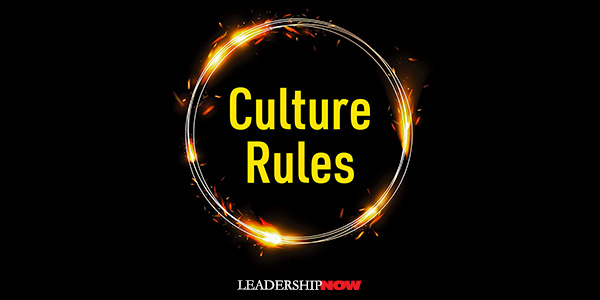
BUILDING a high-performance culture is like setting the rules of a game, says Mark Miller in Culture Rules: The Leader’s Guide to Creating the Ultimate Competitive Advantage. If you don’t “play” the organization will make up their own rules which can and will have unintended consequences. Culture is “a place, physical or virtual, where you set the parameters in which people work. A place where the organization established the rules of conduct and its values, how the game will be played, the options and variables to play, the desired activities and boundaries that govern the game, and more.” In the game of Culture, Miller offers three rules but says there are infinite moves you can make. There are an infinite number of ways to get it done when we think about how we want to shape and build the culture of our organization. You will find many examples others have used in building their culture. Rule #1: Aspire To aspire, you need to create more than a catchy statement. You need a clear purpose. Why does your organization exist? What do you aspire to? What do you value? You must know exactly what you are trying to create. When there is a gap between where you are and where you aspire to be, closing the gap moves you forward. Leaders must constantly share, reinforce, and celebrate their values, as well as challenge those who fail to uphold them. Leaders determine the value and impact of core values in an organization. Rule #2: Amplify Once you have clarity on your aspirations, you amplify them by continuously reinforcing them. “A message not heard consistently is a message without impact.” It’s important to recognize the power of mundane moments, the seemingly trivial actions, and the ordinary encounters. These mark our leadership. These moments happen all day, every day. Without thoughtful actions on our part, these opportunities will be wasted, missed, or worse. If we respond in a fashion contrary to our Aspiration, we can unwittingly undermine our efforts to create the culture we’ve been dreaming of. Rule #3: Adapt Success today is no guarantee of success tomorrow. The world changes, so there must be an ongoing effort to measure and improve the culture. “When leaders are willing to Adapt, not react, to a changing world, they can build or rebuild a High Performance Culture.” Adapting your culture requires continuous listening, learning, and changing. Miller reminds us that the “greatest obstacle to creating a High Performance Culture is a lack of focused attention.” Without the attention, a culture will degrade and succumb to indifference, paranoia, mistrust, counter cultures, and self-deception, to name a few. If people came to your organization because of what they could do and then stayed because of who they could become, I think you would be well on your way to creating your own High Performance Culture—a place known for its unity; life-giving, sold-enriching work; and elite levels of performance. 
Posted by Michael McKinney at 06:37 AM
04.19.21

What You Do Is Who You Are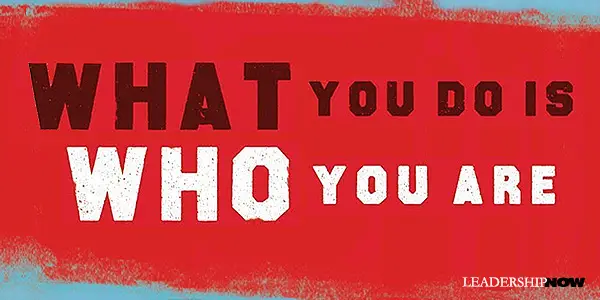
IT HAS BEEN SAID that culture is the most important thing because it determines how your company makes decisions when you’re not there. This led Ben Horowitz to ask, how do you create and sustain the culture you want? He turned to three historical figures and one contemporary that were “outstandingly effective in getting the culture they wanted.” He wasn’t so interested specifically in the culture they produced but what they had to do to change themselves and their culture. In What You Do Is Who You Are, Horowitz looks at the lives of four cultures created by their leaders: Toussaint Louverture, the Haitian slave that led the only slave revolt in human history. The samurai who ruled Japan for seven hundred years and shaped modern Japanese culture. Genghis Khan, who built the world’s largest empire. Shaka Senghor, and American ex-con who created the most formidable prison gang in the yard and, ultimately, transformed prison culture. Companies—just like gangs, armies, and nations—are large organizations that rise and fall because of the daily microbehaviors of the human beings that compose them.
1. Make sure your culture aligns with both your personality and your strategy. How do you know when something is wrong with your culture? Horowitz point to three indicators: The wrong people are quitting too often, you’re failing at your top priorities, and an employee does something that truly shocks you. Some final thoughts: The best way to understand your culture is not through what managers tell you, but through how new employees behave. What behaviors do they perceive will help them fit in, survive, and succeed? By the way, Peter Drucker’s statement that “culture eats strategy for breakfast” actually speaks the exact point Horowitz is making: “What you do is who you are.” If your culture isn’t aligned with your strategy, then culture rules the day. In the long run, a strategy not supported by culture falls flat. Execution works in concert with culture. 
Posted by Michael McKinney at 08:44 AM
01.15.21

Culture Renovation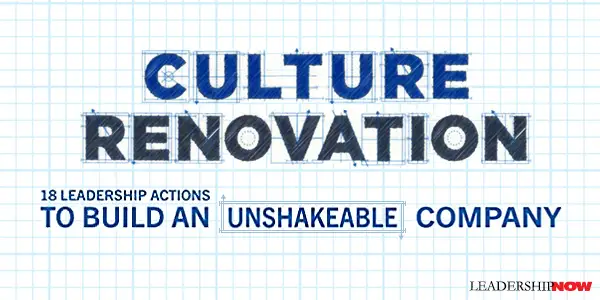
WE hear a lot about changing the culture. And the successful are more like renovations than they are like rebuilding the culture. Kevin Oakes advocates that mindset in Culture Renovation: 18 Leadership Actions to Build an Unshakeable Company Companies that effectively changed their cultures were successful because they were renovating what they had, not starting from scratch and completely rebuilding or transforming. Furthermore, he notes that the best time to renovate your culture is when all is well. Rarely do companies set out to change their culture when everything is calm and running smoothly, even though that is probably the best time to do it. Making the point that culture renovation begins at the top he replays the appointment of Satya Nadella as CEO of Microsoft after Steve Balmer in 2014. Cultural change at Microsoft began on day one. The key change was instilling a growth mindset. Microsoft’s culture had been rigid. Each employee had to prove to everyone that he or she was the smartest person in the room. Accountability—delivering on time and hitting numbers—trumped everything. Meetings were formal. If a senior leader wanted to tap the energy and creativity of someone lower down in the organization, she or he needed to invite that person’s boss, and so on. Hierarchy and pecking order had taken control, and spontaneity and creativity had suffered as a result. The culture change I wanted was actually rooted in the Microsoft I originally joined. The culture change I wanted was centered on exercising a growth mindset every day. The turnaround at Microsoft has been remarkable, and it started at the top. Oakes offers an 18-step culture change blueprint organized equally into three categories: Plan, Build, and Maintain. PLAN Step #1: Develop and Deploy a Comprehensive Listening Strategy. “Before an organization embarks on a culture renovation, it needs to first understand how the current culture is perceived. Too often, the senior team assumes they know what the culture represents. Too often, they are dead wrong.” Step #2: Figure Out What to Keep. Know what stays and what goes. Listen to employees (Step 1) is so important because “it not only illuminates what the culture is today, but it also helps determine the most positive and valued aspects of the company’s historical culture to carry forward.” Step #3: Set Your Cultural Path. “In the spirit of renovation, the new direction should acknowledge and embrace past successes, but set up the organization to forge new ground into an unknown future.” A carefully crafted purpose statement. Step #4: Define the Desired Behaviors. Once you have a short, pithy, and memorable purpose statement, the question is what behaviors will best support that statement. Step #5: Identify Influencers, Energizers, and Blockers. Know the informal organization using an organizational network analysis. Step #6: Determine How Progress Will Be Measured, Monitored, and Reported. “Ultimately, the reason for a culture renovation is to enable the organization to execute on its go-forward strategy. Because this change can sometimes take years, it’s important to define upfront what the indicators of a successful renovation should be, and to put in place mechanisms to monitor progress.” Oakes offers a number of common measures and methods. BUILD Step #7: Clearly Communicate That Change Is Coming. “To kick off a culture renovation, the CEO must articulate the purpose of the organization (whether new, old, or renovated), and that purpose must resonate with employees.” Step #8: Ferret Out Skeptics and Nonbelievers Early. This is the hardest step. “It’s the consistently de-energizing people that ultimately slow down or take down cultures. Ferret them out as early in the renovation as possible.” Step #9: Paint a Vision for the Future. The story matters. “73 percent of successful change efforts relied on stories.” A go-forward vision of the future. Most CEOs of corporate change failure attack previous leadership and focus their messages on the past. Step #10: Consciously Collaborate. Strong internal collaboration is important to drive change. The group must understand why they are coming together and what they are doing. Collaboration can go too far as in the case where “connectivity is through the roof because everyone believes they need to be consulted on decisions.” Step #11: Establish a Co-creation Mindset. “Though almost all successful culture change efforts begin top-down, it is critical to also get the buy-in of the workforce by creating a bottom-up (and middle-out) contribution mechanism.” Consider a Culture Hackathon. Ford “held a two-day event where employees worked in randomly selected teams to generate ideas to either fortify elements of the culture they loved or fix elements that weren’t serving the company well - #hackFORDculture. Step #12: Provide Training on the Desired Behaviors. Train leaders at all levels on the desired behaviors so that they can model them. “While leaders as teachers is one of the most effective ways to reinforce behaviors, it’s clear that successful culture change relies on overall leadership training across the organization.” MAINTAIN Step #13: Make Onboarding About Relationships Versus Red Tape. “If you want to maintain that culture renovation you worked so hard to put in place, you can start by improving your onboarding process.” The most overlooked aspect of onboarding: “Helping the new hire establish a network of trusted subject matter experts who will contribute to that person’s career success.” Step #14: Promote Those Who Best Represent the New. Behaviors that support the renovated culture should be rewarded. Showcase the “career advancement of individuals who best represent the new.” Step #15: Change Performance Management Practices. Most important is the “frequency and usefulness of feedback, clearly defining the business purpose of the performance process, and aligning it with the culture and values of the organization.” Step #16: Leverage Employee Affinity Groups. Interestingly, their research found that two-thirds of companies felt Employee Resource Groups were “more effective than other leadership development forums at developing leadership skills and competencies.” An ERGs primary benefit is to “raise awareness of the different groups of people that make up the workforce of most organizations.” Step #17: Increase the Focus on Talent Mobility. “During a culture renovation, one of the most successful talent initiatives an organization can focus on is rotating talent to strengthen ‘the pack’ and ensure the desired behaviors are exhibited throughout the organization.” Step #18: Don’t Underestimate the Value of External Sentiment. Use external feedback from places like Glassdoor, LinkedIn, and social media to monitor the progress of efforts to renovate your culture. Culture Renovation is less theory and more how to. You will find case studies and interviews with the participants of successful culture change. 
Posted by Michael McKinney at 07:35 AM
08.18.20

Five Frequencies That Are Driving Your Culture (for better or worse)
IS YOUR CULTURE holding you back? Are the signals you are broadcasting as a leader, creating the culture you want—you need? Culture experts Jeff Grimshaw, Tanya Mann, Lynne Viscio, and Jennifer Landis say in Five Frequencies that to make a good culture great, leaders must deliberately transmit strong and steady signals. Leaders create culture for better or worse, through the signals they are consciously or unconsciously broadcasting over five frequencies. To change a culture, you need to broadcast a strong, steady signal on each of these frequencies: Their Decisions and Actions Example is everything—especially when it is inconvenient and costs you something. If it is truly a “value,” what are you willing to pay for it? Think in the long-term. “Go long-term greedy.” “This can mean avoiding ethical shortcuts, hiring people smarter than you, delegating more, and helping prepare high performers for success beyond your team.” What They Reward and Recognize Reward the behaviors you want to see more of. “You are responsible for the dysfunctional behaviors that so bother you.” Everyone brings their emotions to work. “Understand and leverage the emotional algorithms that motivate your people.” Understand that it is all relative, scarcity and timing matter, and everyone appreciates being appreciated. What They Tolerate (Or Don’t) “Leaders are ultimately defined by what they tolerate.” Be sure the boundaries are clearly defined as well as the consequences. And don’t make excuses because you don’t want to feel bad or you can’t hold a particular star performer accountable, or because it’s really no big deal. It’s all-important, and consistency is vital. What you tolerate or don’t tolerate is a balance. “When you decide to become more tolerant of some things (like where people work), you must become, if anything, less tolerant of other things (like the work not getting done). As Harvard professor Gary P. Pisano puts it:” A tolerance for failure requires an intolerance for incompetence. A willingness to experiment requires rigorous discipline. Psychological safety requires comfort with brutal candor. Collaboration must be balanced with individual accountability. How They Show Up Informally When you show up, you “bring the weather.” People notice a leader’s tone, mood, and focus. They are weather in any organization. What do kind of weather do you bring? When considering how you show up, the authors advise you to relinquish your raft. They introduce the concept with a story: A traveler on an important journey comes to a raging river. It seems there’s no way to cross. And that’s terrible news because this is an important journey. Fortunately, she spots a rickety old raft on the bank, off in the brush. With trepidation, she pushes the raft into the water, hops on, and amazingly, uses it to reach the other side. She’s able to continue her important journey. She thinks: I may encounter other raging rivers down the path, so I must keep this raft. So she carries the raft on her back as she continues her journey. It’s a heavy raft, and it slows her down. When fellow travelers point this out, she’s incredulous: “You don’t understand,” she says. “If it wasn’t for this raft, I wouldn’t be where I am today!” And she’s right. That’s literally true. The problem is: If she doesn’t put down the raft, she may not get to where she needs to go on her important journey. It’s your baggage. It’s your reactive tendencies that may have worked for you in the past that are no longer getting you where you need to be. Reactive tendencies like going with the flow, control, the need to be the hero, or being overly protective of your ego, eventually bring you diminishing returns. Their Formal Communications Formal communications don’t work on their own, but they serve to reinforce the other four frequencies. Approach your communications as a story to make it memorable. And say it over and over. “Go past the puke point because that’s often the turning point where employees are just starting to truly get it.” Have a backstory. Know where you came from. “Look for stories of people demonstrating the behavior you want to see more of, especially when it’s not easy for them to do so.” Fill the communication vacuums. “Don’t push your people to the black market.” Know, Feel, Do To establish a reliable culture, you need to measure where you are and where you need to go. The authors call it Know, Feel, Do: what employees know, what they feel, and what they do. The authors advise us to work backward and forwards. Looking forward, they ask, “What is the culture that makes this outcome possible and probable? What will employees consistently KNOW? FEEL? DO?” Looking at each of the five signals, what will you need to broadcast to your employees in each of the five signal areas? It is also necessary to look backward and see where your current culture came from. What did each of the signals contribute to your current culture? It will help you to know what to change in order to close the gap from where to are to where you want to be. 
Posted by Michael McKinney at 04:15 PM
03.06.20

Culture Makes the Difference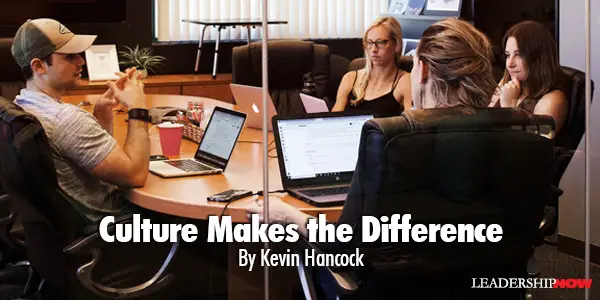
WHAT differentiates companies? It’s generally not products, services, facilities, or equipment. In our industry, for example, our lumberyard competitors sell essentially the same assortment of building materials that we do. Across New England, our white pine sawmill competitors make products that are very similar to our own. Additionally, we all tend to sell our products at comparable prices. So, what differentiates one company from another? Years ago, I would have said it was people who make the difference and separate companies. But I have come to realize that’s not the whole story. Certain companies may think they have the "best people," but the truth is, great people are everywhere—the planet is filled with them. For example, the United States has a more productive economy per capita than Europe, but no one would take this to mean that America has better people than Europe does. America is filled with great people, and so is Europe—and, so is every other country on earth. People are inherently great by virtue of their common humanity. So, if products don’t make the difference, and great people are everywhere, then what separates one organization from another? The answer is culture. Culture makes the difference. An organization’s culture either creates an environment where great people can flourish, or an environment where people are frustrated, held back, or stymied. What makes one corporate culture different from another? To me, it’s all about control and where it lives. Some organizations collect leadership power into the bureaucratic center, where a few people can make the majority of the decisions for the many. This is the traditional model of business—and government—leadership and, during a period of time in human history, this may have been optimal. But, that time has passed. In the 21st century, organizations that disperse power, share leadership, and give everyone a voice are going to win because they recognize and celebrate the capabilities of everyone on the team. These types of cultures don’t see employees as expendable commodities whose purpose is to serve the company. In fact, these types of cultures flip the traditional script by recognizing that the company exists to serve the people who work there. In a great company, profit is an outcome of a higher calling. That higher calling is the celebration of the human spirit and human capacity. In this way, culture makes all the difference. This is why culture is so important to us at Hancock Lumber. We want our company to be a place where every person on the team is trusted, valued, respected, and heard. Work should serve the people who do it in more than just economic ways. Work should be a place where humans flourish—where people learn, lead, and grow. If the employees of a company have an exceptional experience, they will ensure that customers thrive and will protect and grow their company with loyalty and pride. Culture, it turns out, makes the difference. Great people are everywhere, but great cultures aren’t – that’s what separates one company from another.  
Posted by Michael McKinney at 02:27 PM
11.25.19

Hiring for Cultural Fit
ORGANIZATIONS OFTEN TALK about hiring for cultural fit, yet very few of them know how to do it well. This is mostly because they haven’t taken the time to define their culture and, therefore, there’s nothing to hire against or fit into. Instead, a standard set of questions, technical skills, qualifications, and psychometric testing are used in the hope that the right candidate lands in their lap. Where time, money and effort has been invested to define the organizational culture, it’s imperative to use what that definition to bring in the kind of people who will contribute to it, rather than hold it back. The hiring process isn’t an exercise in finding someone with a pulse to fill a position. It’s an opportunity to bring in an individual whose values, intention, mindset, and ambition match that of the organization. Quite often, the most qualified person isn’t the right person for the culture you’ve created. However, it may take one, two, or seven interviews to determine that. In order to ensure that a force for good is added to the organizational culture, time needs to be taken to execute the hiring process well. That way, the person fully understands what’s expected to fit into the culture and the environment in which the work gets done. When the new hire meshes well with these expectations, unnecessary performance management time is avoided. Case studies of how to hire for culture successfully Tony Hseih, CEO of the online shoe retailer Zappos, once famously said that he didn’t know anything about shoes, but knew a lot about creating workplace culture. Zappos has a very well-defined recruitment and induction process, which it calls The Zappos Family New Hire Program. It’s not a rubber-stamping probation period, but a values fit assessment. Every new hire, regardless of role or department, goes through the four-week program, which combines technical training and culture immersion. In the end, the employee has full knowledge of what the organization stands for and how it does business, and the organization can assess the mindset of the individual and how he or she can contribute to Zappos’ values. When hiring at Slack, CEO Stewart Butterfield looks for humility and an acknowledgment that luck has played some part in the job prospect’s success. He also places great emphasis on diversity: “If you don’t have people who come from different backgrounds and experiences, you’ll miss out on meeting the needs of groups of customers.” Ben Kirshner, former CEO at Elite SEM and now Chairman of the Board at Tinuiti, said he’s very particular about who he brings into the culture. , means interviews, on core values. Using an example of having an attitude of gratitude, he explained, “The hiring team will ask candidates a lot of questions to gauge how grateful a candidate is -- how much they appreciate others and how much they give back.” If organizations such as Zappos, Slack, and Tinuiti hired people who didn't share their values, then their culture would become stagnant very quickly as these people would drag others down. Just because they’re qualified doesn’t mean they’ll fit To hire for cultural fit, it’s critical to assess not only an interviewee’s technical skills but also how well the values, emotional skills, and aspirations complement the organization’s culture. To uncover those attributes that can enhance company culture, apply these hiring strategies: 1. Use the organization’s vision statement as a hiring tool. Part of defining company culture is creating an inspirational statement of intent that generates the impetus for moving beyond the status quo. The vision statement can also become a tool for hiring as you determine whether the individual will improve the organization’s chances of achieving its vision. People are often attracted to cultures based on their aspirations. It’s a great way to check that potential employees share the same dreams and understand the agreed-upon ways of working together to realize them. 2. Look beyond a candidate’s skills. While skills may get them an interview, the candidates’ emotional intelligence should be a determining factor in who gets the job. That means the interview should be structured to ensure that emotional intelligence is something you uncover. One valuable question to ask is, “Tell me about your biggest failure.” Being able to admit fallibility is important in a collaborative environment. Also, the best candidates will share how they’ve adapted or changed from the experience. 3. Tailor questions to find out a person’s values. The aim of the interviewing process is to separate those that understand what they stand for from those who just want a job and will say want they think the interviewer wants to hear. Ask candidates to describe their values and how they live them on a day-to-day basis. Include questions around how the candidate would apply the organizational values and remain resilient in stressful situations. 4. Investigate cultural fit. Understand the personalities and skillsets that you already have on board. Once you know your team, and you’ve collectively developed your defined culture, you can look for someone with the right values, personality, and skills to fill the gaps. Hiring any member of staff, regardless of whether they’re permanent or contract, shouldn’t be rushed. If you don’t want to undermine the culture that you have, then it’s important to take the time to find someone who will add to it. Those people will fit like a glove. 
Posted by Michael McKinney at 08:33 AM
08.22.19

Building Company Culture: Alignment Leadership
YOU PROBABLY HEAR the word culture a lot, but what does it mean? We’ll discuss it here but I can definitively tell you this: Without a strong company culture, you can’t create a fulfilling environment for your employees. In fact, the whole idea of culture is a moving target. Yes, it’s widely discussed, but somewhere between the discussion and the implementation something happens. Oftentimes that something is the watering down of the whole idea in the first place and casting it off as a soft science that doesn’t really impact the bottom line. Nothing could be further from the truth. What Is Culture? So, let’s begin at the beginning. What is culture? My definition of culture is the sum of a group of people’s beliefs, traditions, preferences, experiences, and hopes. Any time you put people together, a culture is created. Whether or not you agree with the traits of each person’s worldview—their beliefs, traditions, preferences, experiences, or hopes—that worldview exists. Every person has their own unique worldview, and the way they see the world combines with others to create the culture of that group. The individual traits of a person affect how they view the world and interact with others. For example, the word “trust” means one thing to one person and something different to another person, based on their experiences. The various meanings of trust within a group define their culture around that word. Imagine if a group of ten people working together had vastly different impressions of trust. What kind of culture would that create? Somebody has to clearly define it so that everyone knows what the end game is and how to achieve it. And take note that this is just one word and one idea that can be misconstrued. How many others are there that we assume there is agreement on? Don’t assume. Define. Create a common language and an agreed upon taxonomy that there is no doubt about. Get this right and your organization wins. Misconceptions about Culture Culture cannot be developed by simply creating environments where people congregate together. You’ve been at those events, right? Sometimes it’s a movie night or a day out on a boat or a team building exercise. These are usually great fun and they give us a chance to get to know each other away from the office. But, truthfully, this is just one step in creating a defined company culture. In my journey of leadership, this is a concept I fell prey to early on. In an effort to improve employee engagement, I created happy hours, pizza Fridays, and a party planning committee. What I didn’t realize was that without the initial investment in people before creating these events that fostered community, the experience would be a shallow attempt at culture. Alignment Leadership requires an intimate pursuit of employees, and this pursuit will never happen at a happy hour or a five-minute interaction while sharing a slice of pepperoni. As I began to develop this theory of Alignment Leadership, I realized the real win was much deeper—employee fulfillment. A happy hour can actually be an icebreaker to introduce someone into a community and build a deeper relationship. We go into these opportunities with the intention to further discover our employees, which leads to alignment. You want to develop a culture where you’re able to authentically allow your employees to be known, heard, and valued. Where to Start Creating a culture starts with conversations between you and your people to clearly define the culture you have—and the one you want to build together. You need to have conversations that clarify the culture of your team, the culture of your department, and the culture of the company. This needs to be perfectly understood both from the leader’s perspective and the employees’ perspective. Creating a culture won’t happen overnight. People’s worldviews are deeply rooted in who they are, and combining them into a culture that works for everyone will require people to make changes. It may take several years, but if you put in the effort to lead your team and work together, you can develop an authentic, meaningful company culture. 
Posted by Michael McKinney at 09:44 PM
02.20.19

The Critical Few: Working with Your Culture to Change It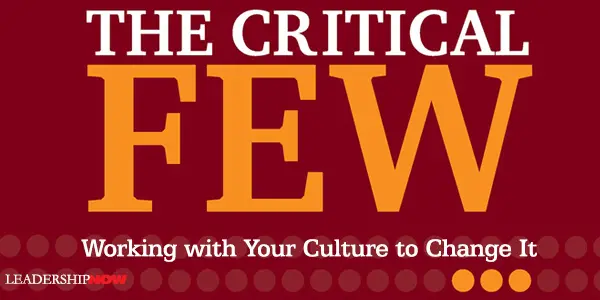
CULTURE is hard to change. And we’re usually fighting against it. But what if we used the culture to change it? What if by focusing on a few critical elements we could work with our culture instead of against it? In the Global Culture Survey 2018 by The Katzenbach Center, a whopping 80% of respondents say their organization’s culture must evolve in the next five years for their company to succeed, grow, and retain the best people. I think we’re all there, so the challenge is how to make that happen. In The Critical Few, the authors—Jon Katzenbach, Gretchen Anderson, and James Thomas—describe organizational culture as “a collection of deeply held attitudes, entrenched habits, repeated behaviors, latent emotions, and collective perceptions of the world. Culture is the shared set of assumptions we all bring when we work together—our unspoken expectations of one another.” It’s easy to underestimate the powerful force exerted by the culture when trying to change it. Instead of issuing top-down, comprehensive, urgent, cultural change directives, you’ll get further faster with real transformation, if you can get the “important emotional forces in your current culture working with you. You identify and make use of what already exists. Chances are, there are some reservoirs of genuine positive emotional energy lurking somewhere within your current cultural situation that can be harnessed if brought to light.” The idea then is to align how people behave and feel—those cultural elements that motivate your workforce—with your goals and what is necessary to make the company successful. But you need to keep it simple. The tendency is to include too much—too comprehensive. Complexity is distracting; comprehensiveness is wasted energy. You need crystal-clear simplicity and a small group of elements that will carry everyone forward together. You need to unify your organization’s people around a common, clear cultural movement, driven by a core of keystone behaviors and positive emotions. It’s easy to create a long list of very important and necessary keystone actions that are vital to building a better culture. But if you can’t narrow it down to three or four, “you’ll be overwhelmed when you start to work with them, and so will everyone else in the organization.” So we need to focus on three specific elements they call the critical few to have the most success: existing cultural traits, keystone behaviors, and authentic or critical informal leaders. Here’s how they describe each: Existing Cultural Traits A set of shared characteristics that represent the “family resemblance” of your entire enterprise—the qualities that transcend subcultures and are at the heart of the shred assumptions people bring to work and their emotional connection to what they do. Traits are not values. They reflect how things are actually done. When we understand what core qualities make up the “family resemblance,” we can than encourage the most the best and useful aspects of those qualities to bring about the change in culture. The traits you choose to focus on should “reflect your company’s essential nature, resonate across the enterprise, trigger a positive emotional response, and support your company’s cause.” Emotional energy is released as traits (and behaviors) are defined because traits, when well-articulated, reinforce and remind people within an organization of their sense of belonging to something larger than themselves. Keystone Behaviors A few carefully identified things that some people do, day after day, that would lead your company to succeed if they were replicated at greater scale. Culture change is slow process, but it begins with specific changes in behavior. As Richard Pascale wrote, “People are much more likely to act their way into a new way of thinking than to think their way into a new way of acting.” You are looking for behaviors that, when encouraged, will move your organization in the direction of your stated aspirations and your strategic intent, all while aligning to those fundamental traits of who you are as a company. Authentic Informal Leaders A few people, or at least a reasonably small percentage of your company’s people, who stand out because they have a high degree of “emotional intuition” or social connectedness. Authentic Informal Leaders (AILs) are people who are already demonstrating the kinds of behavior you want to encourage. And they are not necessarily your high-flyers. These are the people too that can give you a better understanding to how things really work in your organization. Work with them from the beginning. They note thought that AILs may be thought of as skeptics, resistors, and even “mouthy.” Their value is that they “aren’t just there to channel a message—they are there to translate it if they believe in it and also to call foul if they do not and push the leadership to try harder! Their talent for sensing and responding to what others think and feel means that they will choose a way of communicating key ideas that will strike a chord at all levels of the organization.” You can’t point your finger and mandate behavior change. But you can intervene to create the conditions that make the right behaviors emerge. You’re looking to surround your people with a coherent system of “enablers,” some formal and some informal, that all, taken together, suggest a new path. Too often we try to implement changes as an initiative against something when we would be better off working with the prevailing culture to shape something better. These initiatives are usually communication-led transformation rather than a true culture-led, behavior-led, transformation. Communications-led transformations rarely produce a lasting effect on how we feel about what we do and therefore actually change what we do. Lasting cultural changes must have an emotional commitment. You can find more information on this concept on the Strategy& website. 
Posted by Michael McKinney at 08:34 PM
03.19.18

Brand-Culture Fusion: Are You Who You Say You Are?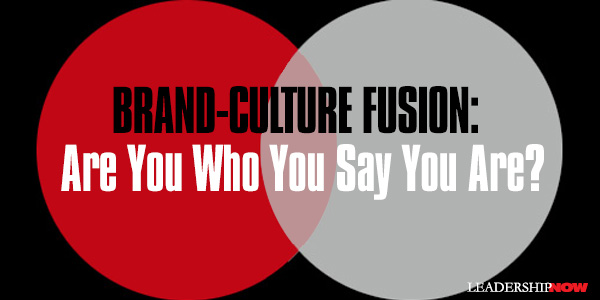
I In Fusion, Denise Lee Yohn makes the case that “you can unleash great power when you fuse together your organization’s two nuclei: your culture—the way the people in your organization behave and the attitudes and belief that inform then (i.e., “the way we do things around here”)—and your brand or brand identity, how your organization is understood by customers and other stakeholders.” She notes that often a company creates a mission statement that states what they want the business to do to create value for their stakeholders and a separate and different brand statement about what they want to be known for. This makes no sense. They should be the same. It simply doesn’t make sense to specify the values through which you engage your employees if those aren’t linked to the way you want your employees to engage customers. Instead, you should bridge the gulf between organizational and brand values by using one set of core values to describe the unique way you do things on the inside and the outside. Your values should function as the “operating instructions” of your organization—that is, they should inform, inspire, and instruct the day-to-day mindset and behaviors of your people. Denise identifies nine brand types: Disruptive, conscious, service, innovative, value, performance, luxury, style, and experience brands. She recommends that you first identify your main brand type that your organization falls into and then identify the kind of culture required to deliver on it. Do the values that currently exist in your organization align with those that correspond to your brand type? Are you who you say you are? Your communications, policies and procedures, compensation, environment, and rituals should reflect the values that exist in your organization. Denise offers a number of ways to do that. It is difficult to transform your culture to define your brand. It’s easier to define your brand by your culture. In some situations, you’re actually better off allowing your culture to lead your brand. If your convictions are so strong that you are more committed to promoting your purpose and values than achieving and particular business or brand goal, then you should prioritize your culture as the driver of your brand identity. Or if you operate in the public sector or yours is an institution such as a science or faith-based organization where a well-defined brand was not needed in the past, you can shape a more authentic brand identity through the inherent values of your people than through an eternal or contrived aspiration. So long as your culture is not fundamentally toxic or dysfunctional, you can use it to shape your brand. Take the FUSION Assessment to determine your “desired culture”—the culture you ought to cultivate to support and advance your brand identity, or the brand identity you’d like to evolve to. You’ll also have an opportunity to assess how far off you are from your desired culture and to pinpoint where you need to make changes in your brand or culture (or both) to fuse them together. 
Posted by Michael McKinney at 11:37 PM
01.17.18

8 Principles for Building a High-Performance Culture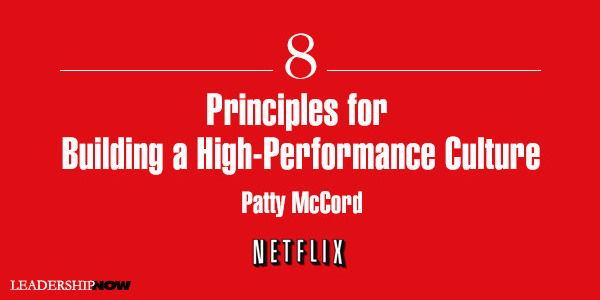
W When McCord began her career in Human Resources at Netflix, she began working with Reed Hastings to identify the behaviors that they wanted to see become consistent practices and worked to instill the discipline of actually doing them. When established they were communicated over and over again and eventually became known as the Netflix Culture Deck. They coached all of their people, at all levels and on all teams, to be disciplined about these fundamental set of behaviors. “A company’s job isn’t to empower people,” she writes, “it’s to remind people that they walk in the door with power and to create the conditions for them to exercise it.” As a leader, you need to model that behavior. If you want people to act like adults, they have to see adult behavior. There are a lot of great insights in Powerful but here are some takeaways for you to think about: 1. Treat People Like Adults “Great teams are made when every single member knows where they’re going and will do anything to get there. Great teams are not created with incentives, procedures, and perks. They are created by hiring talented people who are adults and want nothing more than to tackle a challenge, and then communicating to them, clearly and continuously, about what the challenge is. Saying to employees, “If you do X, you’ll be rewarded with Y,” assumes a static system. Yet no business is static. Being given a great problem to tackle and the right colleagues to tackle it with is the best incentive of all. 2. Communicate Constantly About the Challenge Coming up with simple yet robust ways to explain every aspect of the business isn’t easy, but it pays huge rewards. Don’t hire people that are stupid. Better yet, don’t assume that people are stupid. Assume instead that if they are doing stupid things, they are either uninformed or misinformed. If your people aren’t informed by you, there’s a good chance they’ll be misinformed by others. If you stop any employee, at any level of the company, in the break room or the elevator and ask what are the five most important things the company is working on for the next six months, that person should be able to tell you, rapid-fire, one, two, three, four, five. Ideally using the same words you’ve used in your communications to the staff and, if they’re really good, in the same order. If not, the heartbeat isn’t strong enough yet. 3. Practice Radical Honesty People can handle being told the truth, about both business and their performance. The truth is not only what they need but also what they intensely want. The most important thing about giving feedback is that it must be about behavior, rather than some essentializing characterization of a person, like “You’re unfocused.” It must also be actionable. When leaders not only are open to being wrong but also readily admit it, and when they do so publically, they send a powerful message to their teams: Please speak up! 4. Cultivate strong Opinions and Debate Vigorously Our Netflix executive team was fierce. We were combative in that beautiful, intellectual way where you argue to tease out someone’s viewpoint because although you don’t agree, you think the other person is really smart so you want to understand why they think what they think. “Can you help me understand what leads you to believe that’s true?” We had cultivated the practice of asking people about the nature of problems they were tackling rather than assuming an understanding of them. People become overly wedded to data and too often consider it much too narrowly, removed from the wider business context. They consider it the answer to rather than the basis of good questions. Good judgment: the ability to make good decisions in ambiguous conditions, to dig deeply into the causes of problems, and to think strategically and articulate that thinking. 5. Relentlessly Focus on the Future Leaders rarely look to the future in thinking about the team they’ll need. They tend to focus on what their current team is achieving and how much more that team can do. Another mistake I’ve seen in building teams is assuming that current employees will be able to grow into the responsibilities of the future. This is an especially acute problem for start-ups because founders often feel a strong sense of loyalty to their early team. Are we limited by the team we have not being the team we should have? We were going to make sure our teams were constantly evolving. Just as great sports teams are constantly scouting for new players and culling others from their lineups, our team leaders would need to continually look for talent and reconfigure team makeup. I believe the best advice for all working people today is to stay limber, to keep learning new skills and considering new opportunities, regularly taking on new challenges so that work stays fresh and stretches them. [whether that means rising within the company or seizing a great opportunity elsewhere.] 6. Have the Right Person in Every Single Position At Netflix we had three fundamental tenants to our talent-management philosophy. First, the responsibility for hiring great people, and for determining whether someone should move on, rested primarily with managers. Second, for every job, we tried to hire a person who would be a great fit, not just adequate. Finally, we would be willing to say goodbye to even very good people of their skills no longer matched the work we needed done. People’s happiness in their work is not about gourmet salads or sleeping pods or foosball tables. True and abiding happiness in work comes from being deeply engaged in solving a problem with talented people you know are also deeply engaged in solving it, and from knowing that the customer loves the product or service you all have worked so hard to make. 7. Pay People What They’re worth to You Separate performance review and compensation systems. The tight bind between the performance review process and salary increase and bonus calculations is one of the main factors holding companies back from doing away with the review process. I realized that his work with us had given him a whole new market value. We realized that for some jobs we were creating our own expertise and scarcity, and rigidly adhering to internal salary ranges could actually be harming our best contributors financially because they could make more elsewhere. 8. Proactively Say Goodbye One of the benefits of the leadership communicating clearly to everyone in the company about where you’re heading and the challenges and opportunities that future will bring is that it better equips people to evaluate how well their skills fit into that future. They can also consider whether or not that future is one they want to be a part of and, if it isn’t, can proactively seek out new opportunities. 
Posted by Michael McKinney at 08:30 PM
07.03.15

5 Reasons You Need to Make a Connection Culture Your Highest PriorityA culture that connects people would seem to be a high priority to leaders. Building a sense of community would seem to be a necessary first step before a leader does anything else. But a connection culture is not a common as you might expect.Perhaps this largely because our human nature still leads us to believe that we can always default to command and control when we have to. Or perhaps we just get so busy that we have no time for relationships. We just need to get the work done. Michael Lee Stallard makes the case in Connection Culture that in order to achieve sustainable, superior performance, every member of an organization needs to intentionally develop both task excellence and relational excellence. That is they need to be continually learning and developing healthy relationships with others. Stallard notes that “most organizations contain a mixture of connection cultures, cultures of control, and cultures of indifference, indicating that most leaders are not intentional about developing connection and connection cultures. Creating connection cultures should be an organization’s highest priority because:
Vision: When everyone in the organization is motivated by the mission, united by the values, and proud of the reputation. Value: When everyone in the organization understands the needs of people, appreciates their positive unique contributions, and helps them achieve their potential. Voice: When everyone in the organization seeks the ideas of others, shares their ideas and opinions honestly, and safeguards relational connections. Connection is a character issue. It’s about your attitude, language and behavior. Start on your local culture where you have an influence either formal or informal. Stallard advises that we also “consider how it applies to your family, your neighborhood, the community organizations you are involved in, and other areas of your life, and then take action to increase connection in those spheres as well.” If you are looking to take your leadership to the next level, connect with others at every level. 
Posted by Michael McKinney at 08:08 AM
04.29.15

Creating a Dare-to-Serve Culture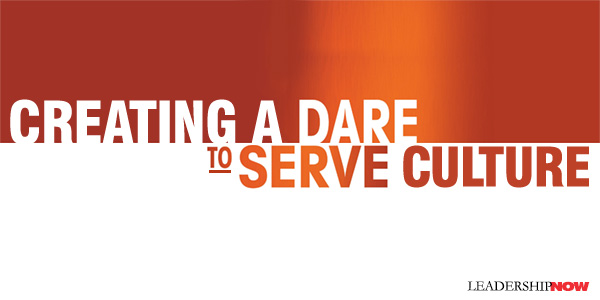
COMMAND and control is a leadership style that is in many ways our default leadership position. It’s very human. Leadership that serves is far more demanding of a leader. These demands easily drive us back into our old styles of leadership. It’s the daily grind that derails our best intentions.
Bachelder lists five benefits to becoming a Dare-to-Serve Leader:
What do you believe enough to act on? These are core beliefs that are so important to you that you will act promptly to rectify the situation when they are violated. Dare-to-Serve Leaders act on three core beliefs: human dignity, personal responsibility, and humility. We tend to be careless with human dignity says Bachelder. We don’t listen, we are impatient, we publicly criticize, and joke in ways that hurt. Push your daily situations through a filter of what you would like someone to do for you. “Lack of personal responsibility in a leader is just another form of self-absorption.” You must look at yourself and understand your own imperfections. “You will have no capacity to serve others unless you can take responsibility for your own self.” Humility is the “behavior” that makes it all work. “We agreed that we are not naturally humble either. That means there are plenty of days we are hell to work for, too. Therefore, humility must be a principle that we have conviction about—or we will never demonstrate humility to our teams. This principle will forever be an aspiration, not an accomplishment. As hard as we try, we will repeatedly fall short.” Bachelder has included 40 reflections for Dare-to-Serve Leaders to help you think about the leader you are. How do you gain meaningful feedback from those you serve?

Posted by Michael McKinney at 11:30 PM
12.05.14

The Culture Engine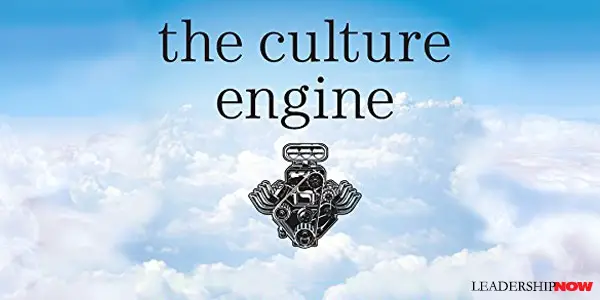
CULTURE is the engine of any organization. It is the force behind everything that happens. It empowers behaviors that communicate who we are whether we like it or not. Getting it right is critical. How do we create a culture that brings out the best in people? Chris Edmonds says that it can be done by the creation of an organizational constitution. “An organizational constitution is a formal document that states the company’s guiding principles and behaviors.” It describes how your organization operates. It makes clear what our expectations are and how we are to achieve them. We have to begin by understanding the truth of how our organization operates. Are we where we want to be? To do that you have to de-insulate yourself, genuinely connect with team members, seek out the truth-tellers, and share your assumptions and what you are learning. Whether we like it or not, we have to “understand that people are acting exactly as you would expect. The way they are behaving now is being reinforced consistently, albeit maybe unintentionally.” In other words, if you are going to define a better way, you have to live a better way. Leaders define the culture. So it’s critical that you live the values and behaviors in your constitution both in and out of the organization. “This scrutiny is unfair, yet it is completely understandable and it is inevitable. You need to expect it and live up to it.” The first element of your constitution is your organization's reason for being. Your purpose statement should be a clear statement of what the company does, for whom, and why. The second element is the “positive values and behaviors you want every leader and employee to demonstrate in every interaction with team members and customers.” These have to be defined in behavioral terms so people have something concrete to measure themselves against. Have a "good attitude" is not specific enough. You can't manage attitudes but you can manage behaviors. The third element is strategy. The strategy represents the path to company goals and expectations. “Every team member should be able to describe how his or her daily projects, goals, and tasks contribute to the accomplishment of team or company strategies.” Edmonds then explains how to manage, measure, and coach others to embrace the organizational constitution. “In high-performance, values-aligned organizations, values accountability is of equal importance with performance accountability. Leaders spend as much time, if not more, communicating, modeling, and reinforcing the department’s values and valued behaviors.” The Culture Engine provides tools in each chapter for making this happen in your organization. The ideas here are not limited to just a few leaders at the top. At any level in the organization, you can make a difference within your sphere of influence. As a leader, you should be intentional about the culture you are responsible to and for.

Posted by Michael McKinney at 01:01 AM
02.19.14

Culture Counts
CORPORATE AMERICA has had no shortage of heroes: Kellogg, Hewlett, Disney, Packard, Kroc, Watson, Ash and Iacocca. These leaders come to mind as examples of lions that have emblazoned their names as corporate giants. But far more important than heroic reputations are the values these captains of industry personified and instilled within their organizations.
The younger workforce presents challenges as well. This generation is far less enamored by traditional organizations and is more independent than any that came before. They can pose major challenges for today’s managers, especially if those managers are part of a different generation. New forms of stimulus and incentives should be created to appeal to these technologically savvy, bright, and environmentally conscious young minds. Presenting more stimulating assignments, frequent two-way dialogue, and company-supported affinity groups can help achieve this. The values of many former great leaders were forged by the experiences of the Great Depression, the wars in Afghanistan and Iraq, and humble beginnings. They understood the impact that a strong, adaptive corporate culture has on organizational performance, the true mark of leadership. They treated workers as their greatest asset, investing in and motivating them. They understood that the purpose of business was to serve the customer. They expected high standards for employee behavior which they themselves modeled and reinforced. Perhaps if today’s business leaders took a page from history, their companies would achieve the success created by the enlightened leadership of past corporate giants. And that would be a good thing. 
Posted by Michael McKinney at 07:32 PM
04.09.12

All In: It’s Culture that Drives Results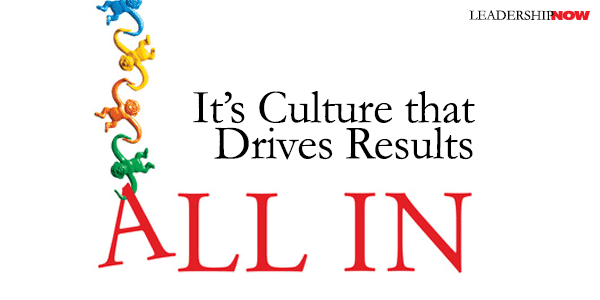
IN THE New York Times, Stephen I. Sadove, chairman and chief executive of Saks Inc., explains that it is culture that drives results: It starts with leadership at the top, which drives a culture. Culture drives innovation and whatever else you’re trying to drive within a company — innovation, execution, whatever it’s going to be. And that then drives results. While we know that our most important resource is our people, it’s not so easy to get people “all in”—convincing people to “truly buy into their ideas and the strategy they’ve put forward, to give that extra push that leads to outstanding results.” All In by Adrian Gostick and Chester Elton explains why some managers are able to get their employees to commit wholeheartedly to their culture and give that extra push that leads to outstanding results and how managers at any level, can build and sustain a profitable, vibrant work-group culture of their own. All In takes the principles found in their previous books—The Orange Revolution and The Carrot Principle—and expands on them and places them in a wider context.They begin by explaining that it all rests on the “belief factor.” People want to believe, but given the fact that “failure could cost them their future security why shouldn’t they be at least a little dubious about your initiatives?” But belief is key. “As leaders we must first allow people on our teams to feel like valuable individuals, respecting their views and opening up to their ideas and inputs, even while sharing a better way forward. It’s a balancing act that requires some wisdom.” To have a culture of belief employees must feel not only engaged, but enabled and energized. What’s more, “each element of E+E+E can be held hostage by an imbalance in the other two.” The authors have created a 7 step guide to develop a culture where people buy-in: Define your burning platform. “Your ability to identify and define the key “burning” issue you face and separate it from the routine challenges of the day is the first step in galvanizing your employees to believe in you and in your vision and strategy.” Create a customer focus. “Your organization must evolve into one that not only rewards employees who spot customer trends or problems, but one that finds such challenges invigorating, one that empowers people at all levels to respond with alacrity and creativity.” Develop agility. “Employees are more insistent than ever that their managers see into the future and do a decent job of addressing the coming challenges and capitalizing on new opportunities.” Share everything. “When we aren’t sure what’s happening around us, we become distrustful….In a dark work environment, where information is withheld or not communicated properly, employees tend to suspect the worst and rumors take the place of facts. It is openness that drives out the gray and helps employees regain trust in culture.” Partner with your talent. “Your people have more energy and creativity to give. There are employees now in your organization walking around with brilliant ideas in their pocket. Some will never share them because they don’t have the platform to launch those ideas on their own. Most, however, will never reveal them because they don’t feel like a partner in the organization.” Root for each other. “Our research shows incontrovertible evidence that employees respond best when they are recognized for things they are good at and for those actions where they had to stretch. It is this reinforcement that makes people want to grow to their full shape and stature.” Establish clear accountability. “To grow a great culture, you need to cultivate a place where people have to do more than show up and fog a mirror; they have to fulfill promises—not only collectively but individually.” And this has to be a positive idea. Gostick and Elton explain that the “modern leader provides the why, keeps an ear close to those they serve, is agile and open, treats their people with deference, and creates a place where every step forward is noted and applauded.” The authors skillfully examine high-performing cultures and present the elements that produce them. A leader at any level can implement these ideas to drive results. A great learning tool.

Posted by Michael McKinney at 11:46 PM
09.19.11

Hypocrisy Isn’t Going to Get You There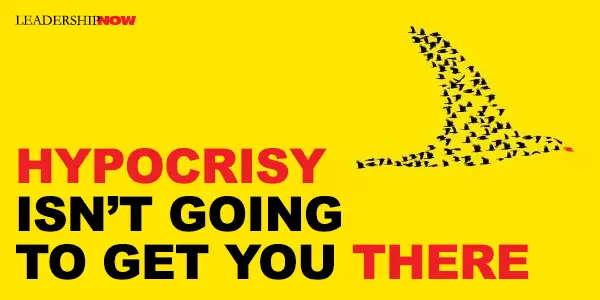
IF you’ve ever asked yourself, “What’s the matter with them? Why don’t they get it?” or said, “I feel like I am alone here,” maybe they are listening more to your actions than your words. Culture explains how things really work. Culture reflects practical values—values that will get you through the day regardless of what you say you believe. When it comes to preaching values, too many leaders are just talking heads. Preach change, demonstrate status quo. Changing culture in an organization is often difficult because leaders make it so. A culture that does not resemble your stated values reflects a lack of ownership and accountability to those values. A value that is meant for “them” but not lived-out in the behavior of and choices made by the leadership, will never become part of the organizational culture. Culture is formed by the choices we make, not the lecture we give. In Too Many Bosses, Too Few Leaders, Rajeev Peshawaria suggests three steps to cultural change: • Define the desired culture. Articulate a set of behavior guidelines for everyone to follow.
In this discussion he makes three statements that are worth reflecting on: Leaders should use every opportunity to exhibit guidelines or values in their own behavior. Are you modeling the behavior you want to see in others? Senior leaders of the company routinely showed up at these training sessions to show employees how important the values and brand were. Are you excusing yourself from what you expect others to be doing? In sharp contrast, another client told me to design the session in such a way that it did not rely too heavily on the executive team’s presence. He argued that the senior team was already under a lot of pressure, and that this would be a huge time commitment for them. I could not believe my ears. After all, as leaders, what do you spend time on if not aligning your organization’s culture with your vision and strategy? Do you live by a different set of rules? Sometimes this is difficult to see in yourself, so asking a trusted friend if there is a disconnect between your words and your behavior is helpful. As a leader, it is too easy to think of yourself as the exception. “I’m busy.” “They don’t have to deal with what I am dealing with.” “This is for them, I don’t need it. When a leader’s behavior conforms to their talk, there is a connective quality formed that is worthy of trust and attention. If we live our values we can create radical change.

Posted by Michael McKinney at 07:07 AM
05.28.09

Culture Eats Strategy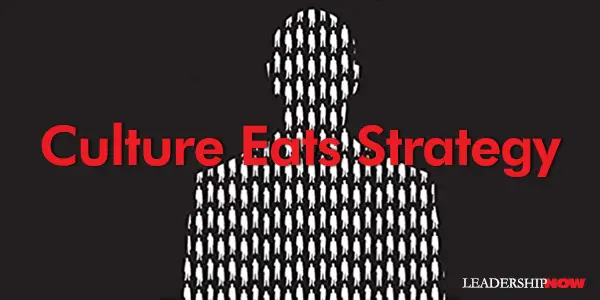
You’re so busy grasping technology in one hand and science in the other, you have no hand left to grasp what’s really important. It’s the human spirit, that’s the challenge, that’s the voice, that’s the expedition.TO create transformation change in an organization you need to change the culture. This may seem to go without saying, but we often try to make changes without changing the underlying belief systems. Belief systems drive behavior. In Transforming Your Leadership Culture, authors John McGuire and Gary Rhodes write, “Organizational culture holds your organization’s aspirations and the spirit of the place. Its beliefs and values define the organization’s core.” To illustrate how endemic the force of belief is within a culture, they relate the following example: Mike, a vice president at National Bank, a prestigious financial organization, tells the story of what came out of an all-day meeting of a group of vice presidents at headquarters: “We brought in VPs and directors from all our locations. We needed to use the largest conference room in the building and had to get special permission to do so.” “Change won’t take hold in operations without change in culture to back it up,” say McGuire and Rhodes. Understanding organizational culture, why it persists, how to change it, and where that change begins is the subject of their book. What beliefs are undermining your change efforts? 
Posted by Michael McKinney at 12:37 PM
05.11.09

Sebastian Coe On Creating a Winning Culture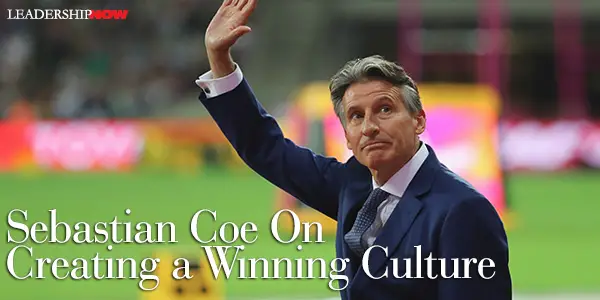
Sebastian Coe, Olympic gold medalist, politician, business leader and chairman of the London Organizing Committee for the 2012 Olympic Games, has written an inspiring book on the mental preparation required for winning in any endeavor. The Winning Mind is a fast-paced collection of life experience that offers evocative insights and expert coaching. Coe believes that leaders are shaped by their “environment, by their ambition, by their role models, by the support they are given as they progress through life and by sheer determination. Our aim must always be that there should be no limit to what an individual from any background can achieve with focus and application — provided they recognize and grab their opportunity with both hands.” Coe says that teams are most productive when they understand the part they play in achieving the final outcome. This requires very clear leadership. “Part of this is ensuring that the work culture is constructive, positive, inclusive and constant.” He offers this advice for creating a winning culture:
How well are you nurturing the conditions necessary to be able to put complete trust in your team? 
Posted by Michael McKinney at 03:27 PM
|
BUILD YOUR KNOWLEDGE
 

How to Do Your Start-Up Right STRAIGHT TALK FOR START-UPS 
Grow Your Leadership Skills NEW AND UPCOMING LEADERSHIP BOOKS 
Leadership Minute BITE-SIZE CONCEPTS YOU CAN CHEW ON 
Classic Leadership Books BOOKS TO READ BEFORE YOU LEAD |
|